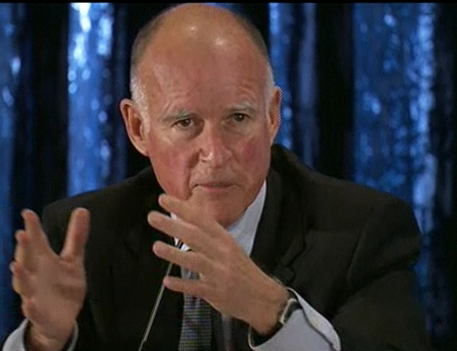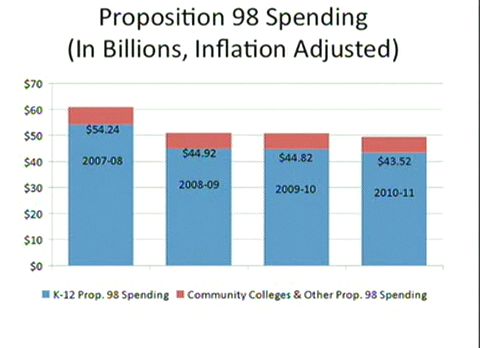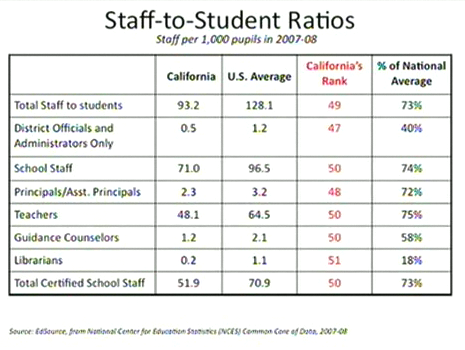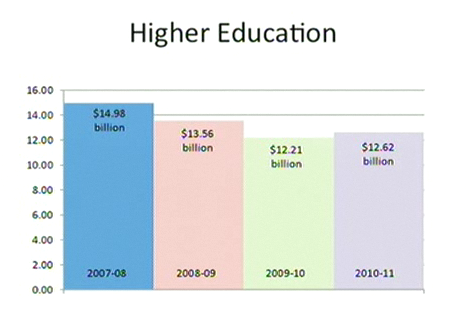Jerry Brown: Cuts To Education Will Continue

Faced with a $28.1 billion deficit for the next fiscal year, Brown is trying to give a crash-course to California voters about how disastrous that figure really is.
The self-described “happy warrior” appears headed down a path of asking voters to extend a handful of temporary tax increases, to raise other taxes and to accept more control over local affairs because cutting 20 to 25 percent from the budgets of state agencies won't alone solve the mess.
“What Jerry is trying to do is getting you to the place where you don't have to deal with the brunt of cash deferrals over and over,” State Controller John Chiang told a group of about 200 educators and politicians at a forum about the state's budget at UCLA.
The event marked the second of three similar discussions Brown is holding throughout the state before he takes office Jan. 3. He'll have to publicly release his proposed budget a week later. Brown said he hopes to submit the budget to the printer on Wednesday and would like to have a budget agreement reached with legislators by mid-March. By warning Californians that his proposed budget will bring them nightmares, Brown seems to be getting ready to tell them that they are going to get a huge drop in public services if they don't approve more ways for the state to collect revenues.
He's given only a handful of clues as to how he'll negotiate a desire from California's residents to direct billions of dollars to education with a similar insistence that they will only write the smallest checks possible to the state.
“A strong, strong majority in the 60 of percents want to spend more on education, but a strong, strong majority of those same 60 percent don't want to pay more taxes,” Brown said. “All those things don't fit together.”
Students in the UC system have had trouble registering for classes, forcing them to take fewer units than they would have liked, because fewer classes are being offered. In many of the classes they do get into, seats are tough to find as professors lecture to several hundred students at once. The system has also had to lay off some of its best teachers, unable to retain and attract the highest quality professors. The loudest frustrations have been expressed against continuing increases to the cost of attending the public universities and colleges.
Three out every ten general fund dollars the state spends goes to funding K-12 education—the largest single piece of the budget pie. A fourth dollar goes to funding the higher education. Combining both together, the budget devotes almost four and half times more money to education than it does to prisons. Yet, the $9 billion in funding for prisons is still double the $5.4 billion given to the UC/CSU systems.
The cuts have led to cries from students and teachers used to some of the lowest tuitions in the country to “Fund the schools, not the prisons.”
Brown said court orders have limited how much the state can cut from the prison system—with about 50 lawsuits still outstanding. Workers in California's prison system account for two-thirds of the state's payroll.
A Legislative Analyst's Office report released in November suggested funding for the UC/CSU systems would remain stable for the next few years. Funding per college student is actually expected to reach its highest level since before the recession.
Brown called education and public safety the pillars of governments.
Brown's finance director appointee Ana Matosantos offered three facts that sets up a predicted push by the governor to get state voters to approve a tax increase in a June special election. California ranks fifteenth in taxes and fees collected compared to personal income in the state. California's teachers are the second-highest in the nation, matching the state's high cost-of-living. Finally, the state's student-to-teacher ratios are among the worst in the nation.
Across the state, voters approved about 60 percent of local bond measures tied to education in November's election, showing a willingness to back increases to education spending.
More than 30,000 pink slips have been handed out to California's K-12 teachers during the past three years, with 21,000 eventually being laid off. Per pupil spending in California was already below the national average pre-recession, but it has continued to sag since 2007. California's public school students, perhaps as a result, are in the bottom tenth when it comes to standardized test scores.
Educators from local school district suggested several ideas to Brown:
- Lowering the threshold for passing a local parcel tax to fund a school district to 55 percent approval from voters.
- Lobbying the Obama administration to focus on formula grants—that are doled based on need—rather than competitive grants such as the Race to the Top program—that are given out based on the merit of applications.
- Removing barriers that keep K-12 schools from offering a full host of online classes. Seat-time, one superintendent said, is an out-dated model for the 21st century.
- Keeping studies of arts and music in place.
- Extending exemptions from federal and state mandates to allow school districts to skirt around some requirements to balance their budgets.
State treasurer Bill Lockyer criticized those ideas, calling teachers out for acting just like the majority of other state taxpayers.
“So far we've heard great ideas about how to spend more, but that isn't going to work,” Lockyer said. “It's frustrating to hear 'Don't cut from us because we're important, should you should spend more on us,' when that's what you universally hear.”
Educators were not persuaded.
“There are no more cuts to be made in public education without devastating the system,” said Joel Shapiro, superintendent of South Pasadena Unified School District.
Lockyer ended the forum by talking about how Singapore’s effort to better fund education about 50 years ago has kept its economy stable.
“Education is a smart investment for everybody, but our constituents are not convinced about that,” he said. “They think it's great if they don't have to pay for it.”
Said Brown, “How do we square that circle? We gathered here so you could tell us.”
Reach executive producer Paresh Dave here. Follow him on Twitter: @peard33.
Here are some charts that were presented by state officials at the forum:






